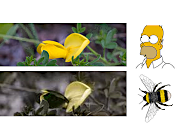The essential is invisible to the (human) eyes: UV patterns explain the increased visit rate of pollinators to the yellow flowers of the Cytisus scoparius bush
DOI:
https://doi.org/10.25260/EA.20.30.1.0.911Abstract
Flower colors are frequently used by pollinators as indirect signals of reward status. However, flower visitors are often UV-perceptive, a nonvisible chromatic spectrum for the human eye. Cytisus scoparius (scotch broom) is an abundant shrub of NW Patagonia that shows intra-specific variation in the color of their flowers. We evaluated whether the previously documented higher visitation rate of pollinators towards yellow flowers is consequence of a more attractive UV pattern in this floral morph. We counted the visitation rate every 4 days along 3 weeks in yellow and red flowers with sunscreens in their petals (which cancel the UV spectrum), control flowers (without sunscreen), and with sunscreen in their pedicels (to control undesirable sunscreen effects like odor). The addition of sunscreen in the petals reduced the visitation rate in the yellow floral morph since the first sampling day. At the last sampling day, yellow flowers with sunscreen in their petals were visited 7 times less than control ones. However, the effect of sunscreen in the petals of red flowers was only evident at the last sampling day, reducing the visitation rate at the end of sampling solely 3 times. These results suggest that both floral morphs show UV patterns and that these patterns attract pollinators, but also that UV patterns are particularly relevant for pollinators in yellow flowers. This may be an effect of a more contrasting UV pattern in yellow than in red background color. Finally, both flower color morphs with sunscreen in their petals showed similar visitation rate, suggesting that pollinators are attracted towards yellow flowers because of the existence of UV patterns rather than being attracted by the yellow color per se. This work emphasizes the importance of analyzing the chromatic patterns invisible to the human eye to better understand the relationship between flower signals and the visitation rate of pollinators.
https://doi.org/10.25260/EA.20.30.1.0.911
References
Asturnatura. Cytisus scoparius subsp. Scoparius (L.) Link. URL: www.asturnatura.com/especie/cytisus-scoparius-subsp-scoparius.html (consultado el: 14/11/18). Núm. 181, 25/05/08. ISSN 1887-5068.
Chittka, L. 1996. Optimal sets of color receptors and color opponent systems for coding of natural objects in insect vision. J Theoret Biol 181:179-196. https://doi.org/10.1006/jtbi.1996.0124.
Gavini, S. S., and A. G. Farji-Brener. 2015. La importancia del color: morfos florales, tasas de visita y éxito reproductivo en el arbusto Sarothamnus scoparius. Ecología Austral 25:204-211.
Guldberg, L. D., and P. R. Atsatt. 1975. Frequency of reflection and absorption of ultraviolet light in flowering plants. A Mid Nat 93(1):35-43. https://doi.org/10.2307/2424103.
Harborne, J. B., and D. M. Smith. 1978. Anthochlors and other flavonoids as honey guides in the Compositae. Bioch Syst and Ecol 6:287-291. https://doi.org/10.1016/0305-1978(78)90047-9.
Johnson, S. D., and S. Andersson. 2002. A simple field method for manipulating ultraviolet reflectance of flowers. Canadian J Botany 80:1325-1328. https://doi.org/10.1139/b02-116.
Jones, C. E., and S. L. Buchmann. 1974. Ultraviolet floral patterns as functional orientation cues in hymenopterous pollination systems. Anim Behav 22:481-485. https://doi.org/10.1016/S0003-3472(74)80047-3.
Knauer A. C., and F. P. Schiestl. 2014. Bees use honest floral signals as indicators of reward when visiting flowers. Ecol Letters 18:135-43. https://doi.org/10.1111/ele.12386.
Koski, M. H., and T. L. Ashman. 2014. Dissecting pollinator responses to a ubiquitous ultraviolet floral pattern in the wild. Funct Ecol 28:868-877. https://doi.org/10.1111/1365-2435.12242.
Lunau, K., S. Wacht, and L. Chittka. 1996. Colour choices of naive bumble bees and their implications for color perception. J Comp Physiol A 178:477-489. https://doi.org/10.1007/BF00190178.
Menzel, R., and A. Shmida. 1993. The ecology of flower colours and the natural colour vision of insect pollinators: The Israeli flora as a study case. Biol Rev 68:81-120. https://doi.org/10.1111/j.1469-185X.1993.tb00732.x.
Møller, A. P. 1995. Bumblebee preference for symmetrical flowers. Proc Natl Acad Sci 92:2288-2292. https://doi.org/10.1073/pnas.92.6.2288.
Morales, C. L., and M. A. Aizen. 2002. Does invasion of exotic plants promote invasion of exotic flower visitors? A case study from the temperate forests of the southern Andes. Biological Invasions 4:87-100. https://doi.org/10.1023/A:1020513012689.
Nuttman, C. V., F. M. Semida, S. Zalat, and P. G. Willmer. 2006. Visual cues and foraging choices: bee visits to floral color phases in Alkanna orientalis (Boraginaceae). Biol J Linnean Soc 87:427-35. https://doi.org/10.1111/j.1095-8312.2006.00582.x.
Papiorek, S., R. Junker, I. Alves‐dos‐Santos, G. Melo, L. Amaral‐Neto, M. Sazima, and K. Lunau. 2016. Bees, birds and yellow flowers: pollinator‐dependent convergent evolution of UV patterns. Plant Biol 18:46-55. https://doi.org/10.1111/plb.12322.
Papiorek, S., K. Rohde, and K. Lunau. 2013. Bees’ subtle color preferences: how bees respond to small changes in pigment concentration. Naturwissenschaften 100:633-643. https://doi.org/10.1007/s00114-013-1060-3.
Primack, R. B. 1982. Ultraviolet patterns in flowers, or flowers as viewed by insects. Arnoldia 42:139-146.
Shrestha, M., K. Lunau, A. Dorin, B. Schulze, M. Bischoff, M. Burd, and A. G. Dyer. 2016. Floral colors in a world without birds and bees: the plants of Macquarie Island. Plant Biol 18:842-850. https://doi.org/10.1111/plb.12456.
Stanton M. L. and R. E. Preston. 1988. Ecological consequences and phenotypic correlates of petal size variation in wild radish, Raphanus sativus (Brassicaceae). Am J Bot 75:528-39. https://doi.org/10.1002/j.1537-2197.1988.tb13471.x.
Thompson, W. R., J. Meinwald, D. Aneshansley, and T. Eisner. 1972. Flavonols: pigments responsible for ultraviolet absorption in nectar guide of flower. Science 177:528-530. https://doi.org/10.1126/science.177.4048.528.

Downloads
Published
How to Cite
Issue
Section
License
Copyright (c) 2020 Varinia B. Vidal, Alejandro Farji-Brener

This work is licensed under a Creative Commons Attribution 3.0 Unported License.
Authors retain their rights as follows: 1) by granting the journal the right to its first publication, and 2) by registering the published article with a Creative Commons Attribution License (CC-BY 4.0), which allows authors and third parties to view and use it as long as they clearly mention its origin (citation or reference, including authorship and first publication in this journal). Authors can make other non-exclusive distribution agreements as long as they clearly indicate their origin and are encouraged to widely share and disseminate the published version of their work.


